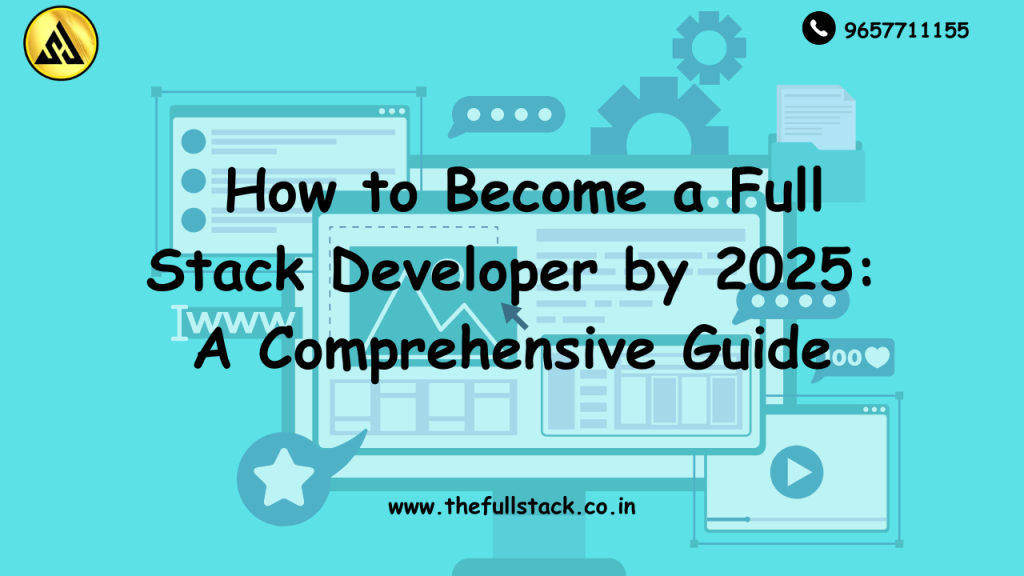Overview
In 2025, there will be a greater need than ever for Full Stack Developers. Professionals with front-end and back-end development skills are highly sought after by businesses, making them valuable assets in the tech sector. This roadmap will walk you through the necessary abilities, resources, and best practices to become a successful Full Stack Developer in 2025, regardless of your level of expertise.
1. Being aware of full stack development
A Full Stack Developer is in charge of database administration and deployment in addition to frontend (client-side) and backend (server-side) development. Proficiency in many programming languages, frameworks, and tools is necessary to succeed in this position.
Principal Duties: Creating user interfaces Developing server-side logic and APIs Taking care of databases Ensuring the scalability and security of applications Application deployment and upkeep
2. Key Competencies for 2025 Full Stack Developers
Client-side frontend development Using the following technologies, frontend development aims to create user-friendly interfaces: Web pages can be structured and styled using HTML5 and CSS3. The primary programming language for web interactions is JavaScript (ES6+). Frontend libraries and frameworks: React.js, which peaked in popularity in 2025 Vue.js (a lighter substitute) Angular (apps at the business level)
- Frameworks for CSS: CSS Tailwind
Bootstrap framework **Server-side backend development ** Database connection, authentication, and logic are handled by backend development: Languages Used in Programming: Express.js with Node.js (based on JavaScript) Python for data-centric apps using Flask or Django Ruby on Rails (suitable for startup) Spring Boot and Java (Enterprise solutions)
- Verification and Safety:
Web Tokens in JSON (JWT) OAuth 2.0 Hashing of passwords (Bcrypt, Argon2) GraphQL and RESTful APIs RESTful APIs for conventional correspondence GraphQL for adaptable data retrieval Administration of Databases Databases are used to manage and store application data.
SQL databases: The most often used Full Stack database is PostgreSQL. MySQL (popular) NoSQL databases: MongoDB (for scalable, adaptable apps).
Firebase (for applications that run in real time) **Development, Operations, and Deployment ** Version control systems: GitLab, GitHub, and Git Docker is used for containerization.
CI/CD Tools: Jenkins, GitHub Actions Cloud platforms include Vercel, Netlify, AWS, and Google Cloud.
Serverless Architecture: Firebase and AWS Lambda Features Soft Skills for Achievement Debugging and problem-solving Good teamwork and communication Adaptability and time management.
3. Top Techniques for 2025 Full Stack Development
1. Maintain Clean and Maintainable Code
- Observe coding guidelines (PEP8 for Python, ESLint for JavaScript).
- Write modular and reusable code.
- Use the appropriate documentation (Swagger for APIs, JSDoc).
2. Put Performance Optimization First
- Minify the JavaScript and CSS files.
- Optimize your assets and photos.
- Use lazy loading to make page loads faster.
3. Verify Best Practices for Security
- Verify user input to stop XSS and SQL injection attacks.
- Make use of secure authentication techniques and HTTPS.
- Update dependencies frequently.
4. Expert Testing and Debugging
- Make use of the browser developer tools.
- Use Jest, Mocha, and PyTest for unit testing.
- Execute end-to-end testing and integration with Cypress and Selenium.
5. Keep abreast with market developments
- Keep up with IT communities and blogs. (GitHub Trends, Hashnode, and Dev.to)
- Take part in open-source initiatives and hackathons.
- Continue studying new libraries and frameworks.
4. Full Stack Development Roadmap (A Beginner’s Step-by-Step Guide)
- Learn the fundamentals of JavaScript, HTML, and CSS.
- Frontend master frameworks: Vue.js or React.js
- Recognize backend technologies such as Spring Boot, Django, Express, or Node.js.
- Use databases such as PostgreSQL and MongoDB.
- Discover best practices for security and authentication.
- Recognize cloud deployment and DevOps
- Engage in practical tasks and develop a portfolio.
- Continue practicing and keeping up on industry developments.
In conclusion
A job in full stack development in 2025 offers countless opportunities and is both thrilling and fulfilling. You may create scalable, secure, and high-performing applications by becoming proficient with the appropriate techniques, tools, and abilities. To succeed as a Full Stack Developer, never stop studying, create practical projects, and keep up with market developments.
Are you prepared to begin? Build your first project and start your Full Stack adventure right now!
you may be interested in this blog here:

